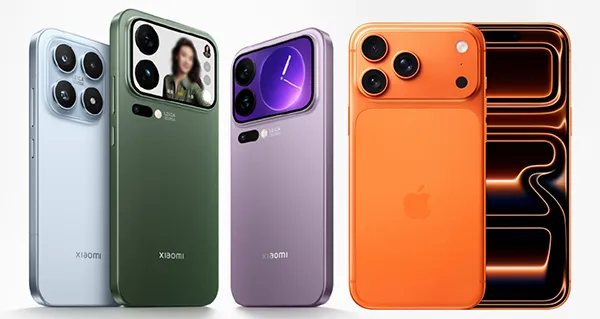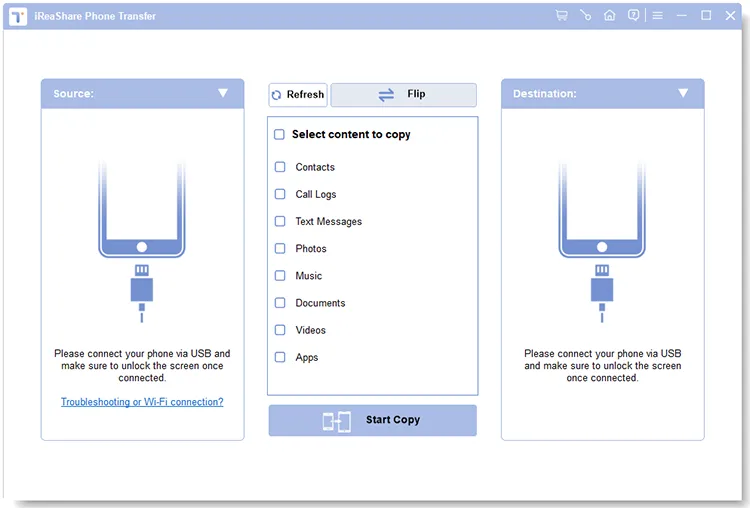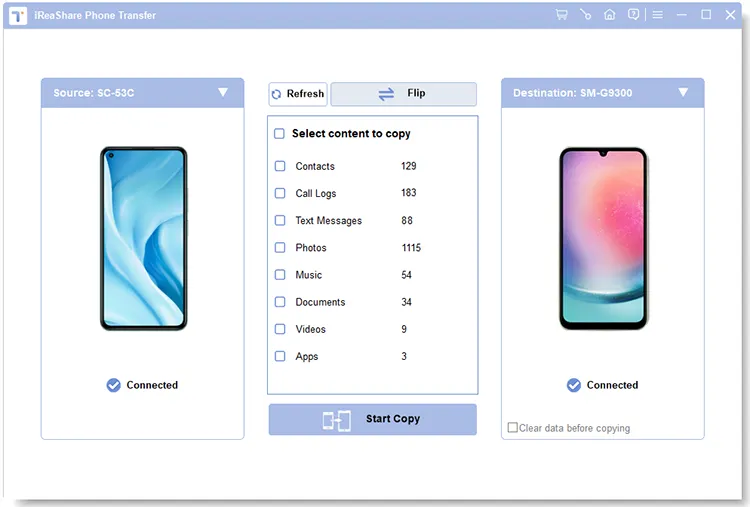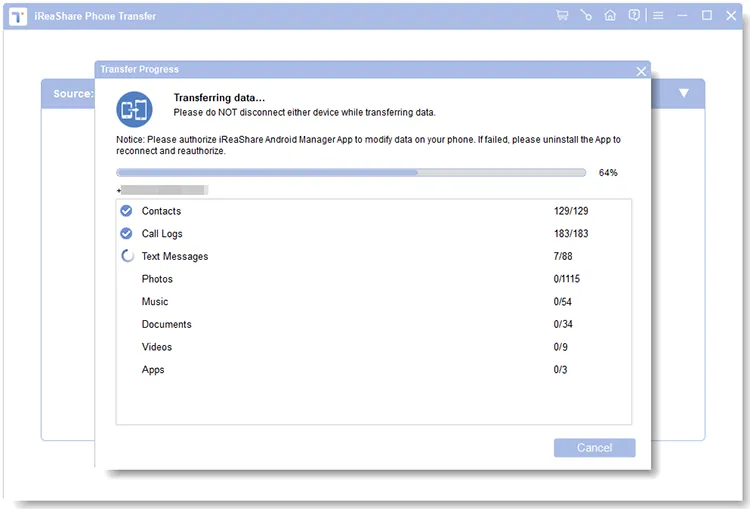The smartphone market is ever-evolving, with each new release pushing the boundaries of technology. This month, the Xiaomi 17 has raised some eyebrows, particularly in comparison to the iPhone 17. While Xiaomi has always been known for delivering high-performance phones at a competitive price, Apple's iPhone has its loyal following due to its ecosystem and premium features. If you want to know about Xiaomi 17 vs iPhone 17, don't miss this guide.

Part 1: Why Xiaomi 17 Not 16
Xiaomi's decision to skip the "16" nomenclature and jump straight to "17" is a calculated strategic move in the competitive smartphone landscape. This approach is primarily aimed at aligning Xiaomi's flagship numbering with Apple's latest iPhone 17 series, effectively avoiding the perception of being a generation behind. By adopting similar numbering, Xiaomi positions itself as a contemporary equal to Apple in the premium segment, rather than as a follower.
This branding strategy serves multiple purposes. It generates significant marketing buzz and media attention, as the unusual skipping of a number sparks curiosity and discussion among consumers and tech enthusiasts alike. More importantly, it symbolizes Xiaomi's ambition to challenge Apple directly in the high-end market.
Read more: If you want to compare Samsung Galaxy S25 Edge and iPhone Air, this guide will tell you what you want.
Part 2: Xiaomi 17 vs iPhone 17
The smartphone market is more competitive than ever, and the Xiaomi 17 and iPhone 17 are two of the most powerful devices available. Here's a detailed breakdown of how they compare across several key categories.
2.1 Performance: SnapDragon 8 Elite Gen 5 vs A19
The performance battle between the Xiaomi 17 and iPhone 17 represents a classic clash of architectures: Qualcomm's latest Snapdragon 8 Elite Gen 5 against Apple's A19 Pro chip. Both processors are built on advanced 3nm process technology, but they take different approaches to performance optimization.
Based on recent reports and benchmark results, the Snapdragon 8 Elite Gen 5 is a top-tier mobile processor that shows excellent performance. It's built on a 3nm process and features custom Oryon CPU cores, with a prime core clocked at around 4.6 GHz.
In Geekbench, the Snapdragon 8 Elite Gen 5 has shown strong single-core scores in the range of 3,700 to 3,850 and impressive multi-core scores often exceeding 11,000. These results are very competitive, and in multi-core tasks, they've been shown to outperform some rivals.
Snapdragon 8 Elite Gen 5 has been rumored to achieve a record-breaking score on AnTuTu, with some reports suggesting it could reach between 4.2 and 4.4 million.
The A19 Pro has shown exceptional performance in Geekbench 6, particularly in single-core tasks. It frequently achieves single-core scores of over 3,800, with some reports even showing it breaking the 4,000 mark under optimized cooling conditions. Its multi-core scores typically fall between 9,700 and 11,000.

2.2 Camera: Leica Triple vs Apple Triple
Take a quick look at the lens modules of Xiaomi 17 and iPhone 17:
| Feature | Xiaomi 17 Series (Pro & Pro Max) | iPhone 17 Series (Pro & Pro Max) |
|---|---|---|
| Main Camera | 50 MP sensor with wide aperture (f/1.6 or wider). Co-branded with Leica. | 48 MP "Fusion Camera" with f/1.78 aperture. Uses pixel-binning for default 24 MP photos. |
| Ultrawide Camera | 50 MP sensor. High resolution for detailed ultrawide shots and macro. | 48 MP "Fusion Camera" sensor, a significant upgrade from previous generations. |
| Telephoto Camera | Dedicated periscope telephoto on Pro Max model for up to 5x optical zoom. | 48 MP telephoto lens with 4x optical zoom. Software can enable "8x optical quality" zoom. |
| Video Capabilities | Advanced video recording, including 8K. | Industry-leading video with professional features like ProRes RAW, Apple Log 2, and 4K at 120fps. |
| Unique Hardware | "Magic Back Screen" on the camera module for high-quality selfies with the rear cameras. | New "Dual Recording" feature to capture video from both front and rear cameras simultaneously. |
| Core Philosophy | Emphasizes high-resolution hardware, unique features, and co-engineering with Leica. | Relies on a unified, software-driven "Fusion Camera" system for versatility and seamless performance. |
| Cooling System | New L-shaped battery and improved thermal design on some models. | Vapor chamber cooling system (on Pro models) for better sustained performance. |
| Overall | A powerful and versatile system with a focus on high-spec hardware and unique features like the secondary screen. | A highly-optimized and cohesive system with a focus on professional video capabilities and computational photography. |
Xiaomi 17 Series Camera
The Xiaomi 17 series, particularly the Pro and Pro Max models, continues its focus on high-resolution sensors and hardware innovation, co-developed with Leica.
- Main Camera: A 50 MP sensor with a large aperture, sometimes f/1.6 or wider. The Xiaomi 17 Pro is being marketed as the "King of Backlight" due to a new "Shadow Hunter" sensor, which promises excellent dynamic range and low-light performance.
- Ultrawide Camera: Also features a 50 MP sensor. This high resolution allows for more detailed ultrawide shots and, in some cases, can double as a macro lens.
- Telephoto Camera: The telephoto lens is a key differentiator. The Xiaomi 17 and Pro models have a 50 MP telephoto lens with 2.6x or 5x optical zoom. The Xiaomi 17 Pro Max takes it further with a periscope telephoto lens that can offer up to 5x optical zoom.
- Unique Feature: The Pro and Pro Max models feature a "Magic Back Screen" integrated into the camera module. This secondary display can be used as a viewfinder for high-quality selfies with the rear cameras, a feature that Apple does not offer.
iPhone 17 Series Camera
The iPhone 17 series, particularly the Pro models, focuses on a "Fusion Camera" system where all rear lenses are 48 MP sensors, allowing for greater versatility and software-driven enhancements.
- Main Camera: A 48 MP sensor with an f/1.78 aperture. The use of a high-resolution sensor allows for pixel-binning, creating a default 24 MP image with enhanced detail and color. It also enables "optical quality" zoom at 2x by cropping the sensor.
- Ultrawide Camera: The ultrawide lens has been upgraded to a 48 MP sensor, a significant leap from previous generations. This allows for sharper images and more detail in macro shots.
- Telephoto Camera: The iPhone 17 Pro and Pro Max feature a 48 MP telephoto lens with 4x optical zoom. Apple's software can then use this to achieve an "8x optical quality" zoom by cropping the sensor. This is a shift from the 5x zoom of the previous generation, which some photographers felt was too long for general use.
- Video: Apple continues to lead in professional video features, with the iPhone 17 Pro series offering ProRes RAW, Apple Log 2, and the ability to record 4K at 120fps. A new "Dual Recording" feature allows you to capture video from both the front and rear cameras simultaneously.
2.3 Ecosystem: HyperOS vs iOS
Xiaomi 17 Series Ecosystem
The ecosystem experience represents one of the most significant differentiators between the Xiaomi 17 and iPhone 17. Xiaomi's HyperOS 3.0 (based on Android) offers a highly customizable interface with extensive connectivity options within the Xiaomi ecosystem.
A notable feature is the "Apple device compatibility" mode, which enables seamless interaction with Apple products, including MacBook file sharing via AirDrop and pop-up connectivity with AirPods. This cross-platform functionality achieves transfer speeds of up to 78MB/s for a 1GB file, effectively breaking down traditional ecosystem barriers.
Besides, Xiaomi's ecosystem is built on a broad, multi-product strategy under its HyperOS platform. It's a vast network of devices that extends far beyond just smartphones.
HyperOS is designed to be a "human-centric" operating system that connects a wide range of devices, from smartphones and tablets to smartwatches, smart home appliances, and even electric vehicles. The goal is to provide a single, unified experience across all these devices.
With HyperOS 2 and 3, Xiaomi has significantly improved cross-device functionality. Features like "HyperConnect" allow for faster data transfer, screen mirroring (e.g., mirroring your phone to a Xiaomi Pad or even a Mac), and seamless app continuity.
Xiaomi's strength lies in the sheer variety of its connected devices. A user can own a Xiaomi smartphone, a Xiaomi Pad, a Xiaomi Watch, a Xiaomi TV, and a variety of smart home devices like air purifiers and light bulbs, all managed from their phone. This offers a high degree of integration for users who are fully invested in the Xiaomi brand.
iPhone 17 Series Ecosystem
The iPhone 17 runs on iOS 26, which is deeply integrated with Apple's own hardware, including the A19 Pro chip. Key to this generation is Apple Intelligence, which provides on-device generative AI features that are seamlessly woven into the OS, from text generation to image creation, all with a focus on privacy.
Apple's ecosystem is defined by its "Continuity" features. Your iPhone, Apple Watch, iPad, Mac, and AirPods work together in perfect harmony. Features like Handoff, Universal Clipboard, and AirDrop are polished to near-perfection, allowing you to move between devices effortlessly. The new "Dual Recording" feature on the iPhone 17 Pro, which can be instantly shared to other devices, is another example of this seamless integration.
The ecosystem is also heavily supported by Apple's services, including the App Store, Apple Music, iCloud, and Apple Pay. These services are key to retaining users and keeping them within the ecosystem. The iPhone 17, with its enhanced features and tighter integration with services, strengthens this bond.
2.4 Battery and Charging: 7000mAh vs 5088mAh
The Xiaomi 17 series is a strong contender in the battery and charging race, with a clear emphasis on large battery capacities and incredibly fast wired charging speeds. The Xiaomi 17 series features some of the largest batteries in the flagship segment.
Xiaomi 17 comes with a substantial 7,000 mAh battery, and the Pro Max version boasts a massive 7500mAh battery, significantly larger than the maximum 5088mAh capacity offered in the iPhone 17 Pro Max, designed for heavy users who demand maximum endurance.
Where the difference becomes even more pronounced is in charging technology. Xiaomi supports 100W wired fast charging that can reportedly replenish the massive 7000mAh battery in just 19 minutes from 0 to 100% . This represents a dramatic advantage over Apple's solution, which still requires 105 minutes for a full charge despite the adoption of USB-C . This charging disparity means Xiaomi users can top up their devices significantly faster when they do need to recharge.
2.5 Display: 2K Screen vs 1.5 Screen
Xiaomi 17 Display
The Xiaomi 17 series uses an advanced M10 screen luminescence technology. Xiaomi claims this technology provides the highest luminous efficiency in the industry at 82.1 cd/A, leading to a stunning visual experience. All models feature impressive brightness. The base Xiaomi 17 has a peak brightness of 4,500 nits, making it exceptionally bright for outdoor use and HDR content.
The standard Xiaomi 17 and 17 Pro have a 6.3-inch LTPO AMOLED display with a resolution of 1200 x 2670 pixels. The flagship Xiaomi 17 Pro Max stands out with a 2K resolution and a new, independently arranged RGB pixel stack designed to eliminate "pixel pooling" and reduce power consumption by up to 26% compared to conventional 2K displays.
All models of Xiaomi 17 support a variable refresh rate of up to 120Hz, providing smooth scrolling and responsive animations. The displays are surrounded by ultra-narrow, uniform bezels measuring just 1.18mm, offering a very high screen-to-body ratio.
iPhone 17 Display
Apple's display approach focuses on a combination of high brightness, durability, and a unified, premium experience across its lineup. The iPhone 17 series features Super Retina XDR OLED panels. A significant change this year is that all models, including the standard iPhone 17, now feature ProMotion LTPO technology, enabling an adaptive refresh rate.
For the first time, all iPhone 17 models support a variable refresh rate up to 120Hz, eliminating the previous tier split and providing a smooth experience for all users. The LTPO technology allows the display to drop to a low refresh rate (as low as 1Hz) for the Always-On display, which is now available on all models.
In a nutshell, the Xiaomi 17 Pro Max stands out with its 2K resolution and a more power-efficient panel, while the iPhone 17 series emphasizes durability and its tight integration with iOS 26 features like the Always-On Display.
2.6 Connectivity & Other Features
Connectivity
All models of Xiaomi 17 and iPhone 17 support global 5G networks. They are also equipped with the latest Wi-Fi 7 (802.11be), offering faster speeds, lower latency, and improved network efficiency.
For Bluetooth, the Xiaomi 17 series features Bluetooth 5.4, which is a newer and more efficient standard than Bluetooth 5.3. Some variants may even support Bluetooth 6.0. Apple iPhone 17 lineup supports Bluetooth 6.0, a new standard offering improved energy efficiency and connectivity with other Apple and third-party devices.
Other Features
USB Standard is a key differentiator. The Xiaomi 17 series provides USB 3.2 on all models, allowing for fast data transfer and external display support. The iPhone 17 series only offers fast USB 3.2 on its Pro models, while the base model remains limited to the much slower USB 2.0.
Xiaomi provides both a modern under-display fingerprint sensor and face recognition, giving users a choice. Apple relies solely on its Face ID system, which it considers to be the most secure.
2.7 Pricing Comparison
Compare the pricing of Xiaomi 17 and iPhone 17:
| Model | Xiaomi 17 Series (Estimated) | iPhone 17 Series (Starting Prices) |
|---|---|---|
| Base Model | CNY 4,499 (~$620 USD) (12GB RAM, 256GB storage) |
$799 USD (256GB base storage) |
| Pro Model | CNY 5,500 - 6,500 (~$760 - $900 USD) | $1,099 USD (256GB base storage) |
| Pro Max / Ultra Model | CNY 7,000 - 8,000 (~$960 - $1,100 USD) | $1,199 USD (256GB base storage) |
| Top-End Model | Varies by configuration | $1,999 USD (2TB storage) |
| Value Proposition | Offers high-end hardware and features at a significantly lower price. | A premium price that includes the value of the tightly integrated software ecosystem and brand reputation. |
| General Strategy | Aggressive pricing to compete on a feature-for-feature basis. | Consistent premium pricing across the lineup, with a focus on delivering a cohesive user experience. |
Xiaomi 17 Series
Xiaomi's pricing strategy is highly competitive, aiming to offer flagship-level specifications at a more accessible price point than its direct competitors. While the official global pricing may vary by region, early indicators and pre-order pricing from China provide a clear picture.
The base model is expected to be priced similarly to its predecessor, the Xiaomi 15. The starting price for a model with 12GB RAM and 256GB storage is around CNY 4,499 (approximately $620 USD).
Pricing for the Pro model is higher due to its advanced features, such as the "Magic Back Screen" and the 100W charging. While not officially confirmed for all regions, it is expected to be priced competitively against other high-end Android flagships, likely starting around CNY 5,500 - 6,500 ($760 - $900 USD).
As the top-of-the-line model, the Pro Max commands a premium for its massive battery and cutting-edge display. The price is anticipated to be at the high end of the Xiaomi lineup, potentially starting around CNY 7,000 - 8,000 ($960 - $1,100 USD).
iPhone 17 Series Pricing
The starting price for the base model has remained the same as the previous generation, beginning at $799 USD. However, this model now includes 256GB of base storage, effectively offering more value for the same price.
The new iPhone Air model is positioned between the standard and Pro models, with a starting price of $999 USD. This model is designed to attract users who want a larger screen and a premium experience but don't need all the "Pro" features.
The iPhone 17 Pro starts at $1,099 USD. This represents a slight price increase over its predecessor, but it comes with a higher base storage of 256GB, justifying the price change for many users.
The top-tier Pro Max model starts at $1,199 USD, offering the largest display and most advanced features. The highest-end model with 2TB of storage is priced at $1,999 USD.
Part 3: Q&A About Xiaomi 17 and iPhone 17
Q1: What is the use of the back screen of Xiaomi 17?
The secondary display on the back of the Xiaomi 17 Pro and Pro Max (often called the "Mi Smart Back Screen" or "Quick Interaction Screen") is a key innovative feature.
Specific uses:
- Answer/reject calls, control music playback, set/check timers, and view notifications.
- Display flight boarding passes, ride-hailing details (car license, ETA), and calendar event reminders.
- Use the rear Leica camera system for selfies. The back screen acts as a viewfinder and control panel (supports photo, video, portrait mode switching, and zoom).
- Quick controls for Mi Smart Home devices (lights, plugs, AC). Deep integration with Xiaomi's SU7 car (e.g., pre-conditioning the cabin).
Q2: The battery capacity of Xiaomi 17 is much larger than that of iPhone 17. Is its body weight also much heavier?
Xiaomi 17 has a body weight of 191g. This is for a device with a 7000mAh battery. Technical specifications for the iPhone 17 list its weight at 177g. This is a standard weight for the base model, which has a smaller battery, 3692mAh. Simply put, the Xiaomi 17 is about 14 grams heavier than the iPhone 17.
Part 4: How to Transfer Data to New Xiaomi 17 or iPhone 17 with Ease
Transferring data to a new phone can be a hassle, but a tool like iReaShare Phone Transfer simplifies the process. Whether you're moving from an old Android to a new Xiaomi 17 or from an old iPhone to a new iPhone 17 (or even between Android and iOS), this software can help.
Furthermore, this program supports most Android OSes and iOSes, ranging from Android 6.0 and iOS 5.0 to the latest, so you can use it to transfer your data from a very old phone to your new smartphone without any trouble.
Download iReaShare Phone Transfer.
Download for Win Download for Mac
To transfer your data to your new Xiaomi 17 or iPhone 17:
-
Please install iReaShare Phone Transfer on your computer after downloading it, and then launch it.

-
Connect both your old phone and new device to the computer with USB cables. On Android, please enable USB debugging. On iPhone, tap "Trust". Then the software will recognize your mobile devices. Ensure your new phone is the "Destination" device, and select the data types you want.

-
Finally, click "Start Copy" to begin transferring your data to your new smartphone. Once done, you can access your data on the new Xiaomi 17 or iPhone 17.

You can also watch the video tutorial to transfer your data with ease:
Tips: After copying your data to your new mobile phone, you can delete your data from your old phone completely before selling your old phone.
Conclusion
Both the Xiaomi 17 and the iPhone 17 are outstanding devices, each with its own strengths. The Xiaomi 17 offers a compelling package with a focus on raw specs, battery life, and fast charging, while the iPhone 17 provides a polished user experience, a powerful ecosystem, and unparalleled software integration. Your choice ultimately depends on your personal preference for operating systems, your budget, and the features you prioritize most.
After purchasing your new phone, you can use iReaShare Phone Transfer to move your data with simple clicks, including your contacts, text messages, photos, documents, and more. This tool can transfer your data without overwriting your existing files on your target device.
Download for Win Download for Mac
Related Articles
Google Pixel 10 vs iPhone 17: Which Is More Suitable for You?
iPhone 16 vs iPhone 17: A Comprehensive Comparison of 16 and 17 Series
How to Back Up iPhone Before Upgrade Without Effort (4 Ways)
Easily Back Up Android Phone to PC Without Data Loss [Tested]





























































